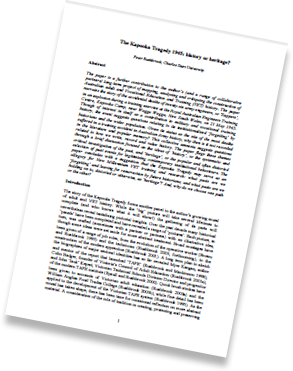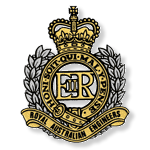1 Field Squadron Group, RAE, Qld Inc.
21 MAY 1945 - 26 SAPPERS DIE DURING
DEMS TRAINING AT KAPOOKA
An extract from The Kapooka Tragedy 1945: history or heritage?
Peter Rushbrook, Charles Sturt University - used with permission.

Click image for full article
You need Acrobat to read.  177KB
177KB
Introduction.
The story of the Kapooka Tragedy forms another panel in the author’s growing mural of adult and VET history. While the ‘big’ picture will take several lifetimes to complete (and who knows what it will show!) the gathering of its parts will nevertheless reveal tantalising pictorial insights.
Over the past decade many historical ‘panels’ have been completed and have revealed a range of ‘pictures’. Each picture, in turn, was crafted (sometimes with a partner or partners) with an illustrative idea, though some ideas were set aside for more abstract treatment. Broad montages have been given of a range of job roles, from the evolution of the operative worker (Brown and Rushbrook 1995) and the technician (Rushbrook 2003, forthcoming), to the construction of the modern apprentice (Rushbrook 2001).
A long term plan to sketch the biographies of major sectoral identities has so far revealed Myer Kangan, author and mentor of the report that launched ‘TAFE’ (Rushbrook and Mackinnon 1998), Colin Badger, founder of Victoria’s Council of Adult Education (Rushbrook 2001a), and John ‘Jack’ Kepert, Victorian Technical Schools Division Director and progenitor of the modern TAFE institute (Spaull and Rushbrook 2000). Quick brush strokes have been given to accounts of Victorian adult education (Rushbrook 2003a) and the William Angliss Food Trades College (Rushbrook 2003b), while fine detail has been applied to the development of the Victorian TAFE system (Rushbrook 1995). As the mural has taken shape, there has been time for occasional reflection on more abstract material. A consideration of the role of tradition in creating, protecting and preserving institutional boundaries (Rushbrook 1997, 1997a) was followed by later musing on the role of history in forming the VET sector’s self-image (Rushbrook and Brown 2001). At the heart of the VET sector is also the enduring theme of ‘the construction the ‘good worker’, an image without which the sector could have hardly drawn breath (Boughton, Brown, Merlyn and Rushbrook 2002; Rushbrook 1995: 93-94). The importance of this particular image will remain for some time the focus of future historical work (for example, Boughton, Brown, Merlyn and Rushbrook 2003).
The image of the Kapooka Tragedy may be located in a distant corner of the vast adult education and VET mural, but, like all carefully crafted works, is worthy of fine treatment. In many ways it symbolises the countless similar stories of education and training that inform and underpin contemporary vocational education practice. But unlike most New Millennium vocational education research, which tends to be located in some kind of abstracted statistical playground, the Kapooka Tragedy is grounded, to paraphrase Manning Clark, in a people, a time and a place (Clark 1975:433). It is therefore unique and not intended to be replicated, collated or averaged for a higher pragmatic purpose. It should be enjoyed as a story of value in itself, yet illustrative of the potential of the science and craft of history and what it can offer to a discipline grounded, it appears sadly, in the continuous present.
The remainder of the paper narrates the Kapooka Tragedy and its aftermath. The evidence consulted represents the first stage of a detailed investigation of the incident.
The narrative is followed by a discussion of the role of ‘history’ and ‘heritage’ in understanding the event’s place in Australian popular memory. By way of analogy, the implications of this discussion have applicability to the history of vocational education practice and its long-term rescue from, in a twist of E. P. Thompson’s words, ‘the enormous condescension of posterity’ (Thompson 1984: 12).
Continued . . .
Click here or image above for full article.

Follow the Sapper.
Make sure you are on our mailing list to receive our bi-annual newsletter and latest updates.